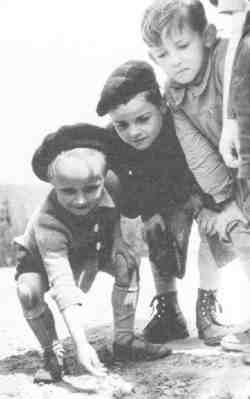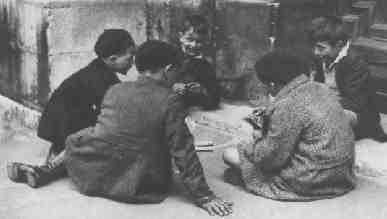
Figure 1.--These French schoolboys were photographed playing in 1936. Note the berets and back-buttoning smock.


Figure 1.--These French schoolboys were photographed playing in 1936. Note the berets and back-buttoning smock. |
French boys in the 1930s mostly wore short pants or knickers and kneesocks. Older boys wore knickers, especially during the colder winter weather. Smocks were still commonly worn to school. French boys also wore a distinctive cloak garment in the winter. Berets were also still widely worn. Some readers have noted major changes in boys' fashions firing the mid-1930s.
A French reader has noted major changes in French boys' fashions during 1920, 1936, and 1968. HBC understands the changes in 1920 and 1968. The chabfes in the early 1920s resulted from World War I. The changes after 1968 resulted from the Paris student ruots and associated trends. We do not understand, however why major changes occurred in 1936 and what was the nature of these changes. This is a subject HBC hopes to persue. A French reader reports "'Les congés payés' (paid leaves introduced during the 1930s had an important impact on the society. It may be also the uncertainty developing with the rise of NAZIism in Germany and increased anxiety about the increasing possibility of war reinforce a desire to cherish one's children which may have been reflecting in fashions."
A French reader provides us some information about social trends affecting clothing during the 1930s. "The French children in the cities were better dressed than those in rural areas. It must be said farmers were often rather poor
in past times. The school educational was the same for everybody. So the
principles in children matter are known for all. The social system is very protective and the children are much loved by their families. We give much attention to the children and by instance the rules must be respected concerning child labor, their labor, their look, and their behavior. So we would choked to see a child without shoes or dressed like an adult, or a little girl with make up by instance . Perhaps that mean a sort of abandonment or at least a lack of attention by their parents."
A French reader writes, "I have known the styles an fashion trends of the 1930s and the atmosphere of the 1930s. I have to clarify that the French mother never mistake about boys and girls because of the way children looked. Each gender had its own style and look and the rules were well known. Of course it was not acceptable for boys to wear girls' garment, but the juvenile look was completely normal for us. It was not considered appropriate for a boy to dress a boy in too adult a fashion. Boys dressed that way were commonly from poor families. I recall that our parents dressed my brother, sister, and myself very smartly. We were never teased about how we were dressed. French mothers were proud about their children looked. Regularly in cities they were beautiful baby competitions. The French children were dressed did not really change until after 1968. Children's clothing has become increasingly international in a way they we not in the 1930s. I have noticed , the new French generation don't know very well our period , only by the familly photograph . They may know they were " petite fille modèle" and "petit garçon modèle", sometime in TV this reference is copied , alike culotte courte is giving for a boy well dressed of traditional good familly . This term is always also currently used to describe the little boy world.
HBC has collected some information about fashions trends associated with specific garments diring the 1930s. French boys by the 1930s, no longer commonly wore dresses as they did in the 19th and early 20th Century. Very young boys or wealthy boys might wear them, but it was becoming unusual. Boys like men still commonly wore hats or caps during the 1920s-40s. The most common head gear for French boys were berets. Available pictures show both scouts and school boys wearing them. Headgear was more popular in the 1930s than today. So most boys would commonly wear some kind of cap. We notice a lot of images of fashionable French boys wearing knit suits after World War I. We are not sure when they began wearing them. This style of knit suit was especially popular in the 1930s before World War II. French boys in the 1930s mostly commonly wore short pants. Most boys wore shorts all the time even in the winter. Some older boys wore knickers. Some boys had long pants that they wore during the winter months. Shorts were worn for play, school (under smocks), and for dress occasions as short pants suits.
French boys by the 1930s, no longer commonly wore dresses as they did in the 19th and early 20th Century. Very young boys or wealthy boys might wear them, but it was becoming unusual.
Boys like men still commonly wore hats or caps during the 1920s-40s. The most common head gear for French boys were berets. Available pictures show both scouts and school boys wearing them. Headgear was
more popular in the 1930s than today. So most boys would commonly wear some kind of cap. I'm not sure what was generally worn by boys wearing
suits. I'm also not sure if there was some age associated with berets.
I think boys up to about 13 wear them with their suits, but after that
hats became increaingly common. These are primarily guesses on my
part and I'd be interested in comments from comtributors.
We notice a lot of images of fashionable French boys wearing knit suits after World War I. We are not sure when they began wearing them. This style of knit suit was especially popular in the 1930s before World War II. A French reader writes, "This and similar outfits were commonly worn by French boys before the War." One can indeed find a lot of these
outfits in fashion and sewing magaines during and photographs during the 1930s. They were very commonly worn, including by schoolage boys. HBC does not have a good understanding of when French boys began wearing knit garments besides sweaters. HBC has noted French boys wearing knit shorts sets in the 1930s. They may have appeared earlier. Knit shorts presumably made out of wool seem like rather uncomfortable clothing in warm weather. In many cases these short sets were also worn in the Fall and Winter.
French boys in the 1930s mostly commonly wore short pants. Most boys wore shorts all the time even in the winter. Some boys had long pants that they wore during the winter months. Shorts were worn for play, school (under smocks), and for dress occasions as short pants suits. French boys, even older boys, commonly wore shorts during the 1930s. French
short pants by the l930s for little boys could be quite short. Older boys wore them longer, but generally shorter than in England--often well above the knees, and not as baggy. Younger boys might wear short pants all year round, including the winter--but with knee socks. Some mothers might buy long pants for winter wear. Most boys, however, mostly wore shorts. Short pants were especially common in the summer. Boys who might have worn long pants to school might wear shorts in the summer, usually without kneesocks. At the time, French boys did not wear jeans. Thus a comfortable, cassual style of long pants did not exist. This made it more common for older boys to wear summer shorts. I'm not sure what the boys thought of wearing short pants. AS so many boys wore shorts, they probably did not think about it much. They may have preffered longs in the cold winter months. Older boys probably began to want longs. I'm not sure at just what age boys wore shorts, but it appears that most boys wore short pants through at least 13 and then gradualy began shifting to longs. There were still a lot of boys waring shorts
at 15, but the number appears to have declined by 16 or 17. Many of these older boys would be wearing knicker or long pants.
Formal short pants suits were mostly worn with knee socks, but ankle socks were often worn on more casual occasions and were most common
during the summer. Kneesocks were somewhat less common than in
England. Short pants suits were made for boys in sizes uo to 16 years. Boys from 8 to 16 years of age might have a suit with both a pair of short pants and a pair of knickers. The length of the shorts varied. Some boys, especially older boys, might still wear quite long shorts in the 1930s. Kneesocks were commonly worn with shorts when dressing up in a suit. HBC has little information about colors, but lighter colors appear to have been popular. HBC does not note a lot of dark colored suits.

Figure 3.--French boys in the 1940s and early 1950s still commonly wore berets. Notice that this photograph taken during the fall or winter shows the boys still wearing short pants under their coats. |
Play clothes were most likely to
be short pants. Courderoy shorts were very popular for play and for scouts in the 1940s, I'm not sure if they were also worn in the 1930s.
French mothers adapted a number of styles for such as modified Fautleroy suits with
short shirts, white kneesocks, and strap shoes. These styles were mostly for little boys, but some older boys wore them for special occasions. It is unknown to what extent such outfits were worn. Most of the photograhps I have seen come from modeled post cards, rather than actual family photographs.

Figure 4.--French boys in the 1930s might have suits with both shortpants and knickers. This 1936 ad offered short pants suits in sizes up to 16 years. Note the solid color kneesocks. |
Short pants and knickers were widely worn by French boys in the 1920s and 30s. The knickers would often be reserved for cold weather winter wear, although many boys wore short pants all year round with kneesocks for warm in the winter. The estimates are based on the sized produced and sold in the stores and are thus an accurte estimate of what boys wore.
Actally you would have to add a couple years to the ages because most boys would
wear a suit for at least 2 years after it was purchased. Thus a boy
bought a short pants suit at age 16 might we ar it until about 18 or when he
finished secondary schools. Knickers were primarily worn by older boys or for cold
weather wear. They were commonly dress wear with a suit. Little boys
would be unlikely to play in knickers. Older boys from 14 to 19 years might
have a suit with a pair of knickers and a pair of longs. Boys of 19 might wear knickers until they were 21!
Shorts were commonly worn to school, but in many cases under school smocks. I believe that almost all boys wore shorts to school, although some might shift to longs during the winter. I think that, however, was not real common as I can recall few pictures of French boys in smocks and long pants. Even some younger boys in secondary schools wore shorts, although knickers became more common for the older boys and most senior boys wore long pants.
French boys commonly wore kneesocks with their short pants. Kneesocks were particularly common in the winter. I think that the solid colors were the most common, especially gray. I'm not sure if boys commonly wore white kneesocks. Some Catholic schoolboys wore white kneesocks in the 1950s, I'm not sure when this began. Wearing kneesocks was less common in the summer. Certainly not having to wear long stockings in the summer must have been more
comfortable.

Figure 5.--The beret, cloak, short pants, and kneesocks were standard wear for French boys in the 1930s. |
Smocks were still commonly worn by French school boys in the 1930s. They do not seem to have been qyuite as common as in earlier years. I'm not sure if the French Government revised regulatiions, leaving it up to individual schools, but this seems likely. Even so they were still worn by many elementary school boys. Styles varied, but the back buttoning styles appears to have been the most common. The colors were mostly black, blue,
and gray. Lighter more colorful smocks were mostly worn by girls. Gingham was a popular material for smocks, especially for girls. Some boys also wore ginham smocks. I'm not sure to what extent French boys wore smocks, other than for school. Hopefully some of our French contributors can supply information on this subject.
French boys wore a variety of shoes. Both oxfords and high-top leather shoes were worn by boys up to about 13 years of age. French boys did not commonly wear sneakers, but different styles of sandals were worn. Closed toe sandals appdear the most common, but open-toe were also. It was particularly popular to wear sandals during the summer.
Younger boys in the 1930s might still wear curls. A reader tells me about a book on the French people written by a gentleman who spent most of his life in France in the diplomatic service has a whole chapter on French men and woman. He is in love with French woman but has a very low opinion of French men, saying that they are a spoiled lot because of their upbringing. "I learned long ago not to have committed the faux pas of remarking to the mother of a young child wearing bloomers and long curled hair: 'what a pretty little girl '". Often as not the child turns out to be a boy and the mother is insulted that you could possibly mistake her little boy for a girl. The contributor opines, "The diplomat may have been right about Frenchmen being spoiled. The generation he is talking about grew up between the world wars. A whole generation of French boys were wiped out in World War I. I can see why boys born after that War were cherished by their parent and grandparents. The long hair and even hair bows worn by French boys in the late 19th and early 20th Century had generally disappeared for schoolage boys by the 1930s. Most boys wore short hair.
French family: 1880s-90s (The De Lesseps)
French family: 1890s-1900s (The Renoirs)
French family: 1890s-1900s (Paul)
French family: 1890s-1900s (The Zolas)
French boy: 1900s (Jean Daubeville)
French boy and smocks: 1950s-60s
Jean and Claude: The 1930s
French boyhood: The 1960s
American boy in France: The 1960s
American boy at French school: 1960s
Navigate the Boys' Historical Clothing Web Site:
[Introduction]
[Activities]
[Biographies]
[Chronology]
[Clothing styles]
[Countries]
[Topics]
[Bibliographies]
[Contributions]
[FAQs]
[Glossaries]
[Satellite sites]
[Tools]
[Boys' Clothing Home]
Navigate the Boys' Historical Clothing French pages:
[Return to the Main French page]
[Return to the Main French inter-war page]
[French choirs]
[French school uniforms]
[French school smocks]
[Royalty]
[French sailor suits]
[French scout uniforms]
